Discover How To Use The Power of Authority Marketing To Make You Money While You Adventure!
No Experience, Existing Product Or Technical Skills Are Required
DO YOU BELIEVE ADVENTURES ARE WORTH CHASING?
We're an affiliate.
We hope you love the products/services we recommend on Just Van Life! So you know, there is the possibility we will collect a commission should you make a purchase via any of our links. This will in no way affect the purchase price. Thank you for your support, we really appreciate it!
Owning a camper or RV is an excellent way for you to get out there and see more of the outside, with endless possibilities, but if you’ve just bought one or done checks on yours, you could find your flooring needs replacing.
While this doesn’t sound too bad, the flooring plays a role in the level of comfort and the value of your camper when you go on to sell it, and getting the suitable materials down can prevent any water damage from spreading even further.
You can find a step-by-step guide below on how to replace flooring that just isn’t cutting it and how simple this is to do over a weekend with a few tools.
Does Your Camper Need New Flooring?
This depends on the type of flooring you have. As with carpeting, you can usually tell when it needs replacing as it will look worn by use or by hairs made from pets, and if it’s older than eight years, you should replace it anyway.
For vinyl and wood flooring, the best way to tell is by looking for tears and cracks or possible signs of dampness caused by a leak somewhere, which can, in turn, affect the bottom wood layer.
You should also replace it if it feels or looks uneven or it creaks when you apply pressure to it, as this is a sign that one of the floor layers is failing somewhere.
Remove Cabinets And Installations
Before you do anything, move your camper into a garage and lift it using a jack or stilts to have better access to the flooring.
To get a picture of how much work you might have to do, it’s best to remove items that cover most of the floor, especially over wheel arches and joints, including dinettes and seating areas.
If you see signs of rotting or dampness on this level, you will have to remove any paneling and explore further to find the cause, and this may mean stripping it out completely, and you can find out what to expect below.
Pull Up Vinyl And Wood Boards
Once you’ve removed the vinyl and second layer, you’ll get to the styrofoam layer that acts as insulation that is usually segmented, so you don’t have any hot or cold spots. In some models, you can find a foil layer that is an underlay. You can replace these if needed.
Once you get to the bottom layer, you’ll find that you can cut through it quickly, so a pair of heavy-duty scissors or garden cutters should do the job, but you want some overhang when cutting as you want something for your new nylon overlay to attach to.
It’s a good idea to strip this all down, especially if you can see signs of water damage, so you can see where it comes from and seal any edges or patch any holes that may have occurred over time, and it’s best to check for these signs every six months or so.

Fit Underlay To Size
First, you want to attach your nylon underlay, and if you get a 5-10ft roll and fasten it in place, you should have an adequate amount to cover the space you’re replacing.
You can now fit your flooring as you want to fit ¾ treated plywood as your base layer, which you can find made to fit by going to a wood retailer.
You want to cut these, so they are in two to three panels and make sure they fit tight to the camper’s walls. Otherwise, you risk any dampness or cold coming through, and you’ll likely have to do this again sooner than you’d hoped.
Be sure at this stage to check the level of your flooring, and if you have any loose pieces of underlay, you can nail or staple these down, and they should be tight and snug.
Fit Beams And Other Layers
With a secure floor in place, you can install crossbeams from wooden batons, or you can find some outlets with premade crossbeam designs, but it is usually cheaper to find and fit them as you can configure these batons to the size and shape of your camper.
Be sure to space these out evenly and use a higher concentration of these near seating areas to give you support as you use them, and you can wedge them in and stick them down for added support.
In between these gaps, you can cut styrofoam, so it fits into place, and here you can add another layer of plywood as you have done for the second layer, but be sure to measure the height of each layer so it doesn’t take up near doors and seating areas.
With this in place, you can add a vinyl or wood panel floor of your choosing, and with vinyl, you can get rolls that cost under $10 per square foot. When laying it, you want to roll out any air pockets.
Reinstall Cabinets And Do Final Checks
Once you’re happy with the result, you can reinstall any cabinets or seating you’ve taken out, and here you can see if any ends stick up that you can cut and adjust so you get a tight fit and a fine finish.
Be sure to check after a while to see if any leaks are coming through, which you can seal. If this has been fixed and you still find leaks, there may be a problem with the exterior, so inspect the outside and see if there are any gaps and holes.
Conclusion
With this, you can see how easy it is to do, and if you find you’re struggling with materials and methods, you can go to a retailer or dealership, and they can point you in the right direction.
Discover How To Use The Power of Authority Marketing To Make You Money While You Adventure!
No Experience, Existing Product Or Technical Skills Are Required
DO YOU BELIEVE ADVENTURES ARE WORTH CHASING?
